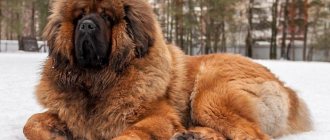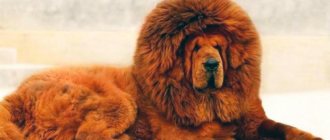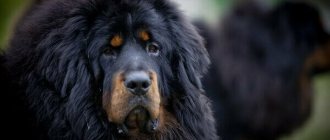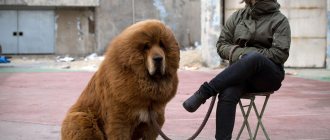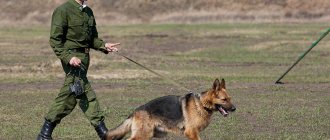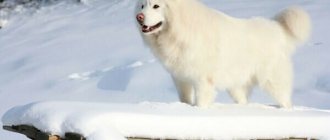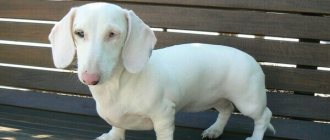Review author: “ZooVita”
It is simply impossible not to notice such a handsome man and a giant, because the height of the Tibetan mastiff sometimes reaches 62 cm and above. The pet is striking not only with its enormous size, but also with its incredibly thick fur and interesting color.
According to its name, the giant comes from Tibet, where dogs were first used to guard Buddhist palaces and settlements. A photo of a Tibetan mastiff will allow you to appreciate all the features of the giant’s appearance.
Description of the Tibetan Mastiff breed
Popularity 131st among 263 dog breeds
Lifespan:
10-11 years
Height:
males: from 66 cm, females: from 61 cm
Country of origin:
China, Tibet
Average price:
50-70 thousand rubles
Weight:
64-78 kg
Latest articles Cat health
Rabies vaccination for cats: choice of vaccine, necessity, schedule 01/22/2022 20 0 0
Selection and adaptation
TOP 20 best cat breeds for families with children 01/22/2022 33 0 0
Can you keep it on a chain?
Under no circumstances should this breed be kept on a leash. Constant keeping in an enclosure is also contraindicated; it should be closed there only when absolutely necessary, when strangers are in the house. The cage for the Tibetan Mastiff is made spacious and strong; it is not recommended to install a thin wire mesh or chain link.
If a Tibetan dog is left to roam in the yard, the fencing system should be of an appropriate height.
Key facts
The name of the breed is a kind of pointer to the country of origin of the dogs, Tibet, that is, China. The description of the Tibetan Mastiff breed allows for other names - Tsang-Khi, Molosser, Bho-Thai; abbreviated names (Tibetan, Mastiff) are used quite often. Nicknames should be chosen based on the “purpose” of the pet: watchdogs can be addressed briefly, while pets can be given long nicknames.
The life expectancy of the Tibetan Mastiff is relatively short - 10-12 years, but its health is excellent. Animals live active and full lives even in old age. In this regard, their character helps them: active, balanced, proud and in some ways even dominant.
The large size of the Tibetan mastiff makes it difficult to keep it in an apartment, but in a country house with a fenced area the animal will feel like in a palace. The average weight of a Tibetan mastiff is 64-78 kg (for females, a weight of 4 kg less than the norm is allowed, for males - 2 kg more). Height (height at the withers) for males starts from 66 cm, for females – from 61 cm.
The breed is not popular in the CIS, since for a long time it developed only in Tibet, China, and Nepal. You can count the number of nurseries breeding Tibetans on one hand. Rarity is one of the reasons why the price of purebred giants with a good pedigree starts at 60,000 rubles. But at the same time, the characteristics of the Tibetan Mastiff breed are almost impeccable.
About the breed
The breed first appeared in Tibet long before the advent of writing. Scientists, by comparing wolf and dog DNA, were able to determine that these two species began to differ approximately 42 thousand years ago.
When comparing the DNA of the Tibetan breed, it was possible to find out that this breed began to have differences even earlier - about 58 thousand years ago. Thus, we can safely say that this is one of the oldest dog breeds in the world.
Mastiffs first appeared in Tibet in monasteries. They were used to protect monasteries and ensure peace of mind for the monks.
At that time, the mastiffs' partners were Tibetan spaniels. While the spaniels raised everyone up with their barking, the mastiffs fearlessly protected the novices from attacks.
Note!
- Nicknames for dogs for boys - easy, rare and most beautiful names for dogs in alphabetical order
- Nicknames for girls' dogs - a list of beautiful, funny, unusual nicknames for large and small dog breeds
- Maltipoo dog - everything about the dog from A to Z. Photos, description of the breed, character, maintenance features, prices, reviews
History of the origin of the Tibetan Mastiff
No researcher can say exactly where, when and how Tibetan mastiffs appeared. Dogs of this breed, judging by the many genetic analyzes carried out, are one of the direct descendants of wild wolves domesticated by ancient man. Archaeologists managed to find the remains of dogs similar to Tibetans that accompanied people living in caves. Mentions of man’s formidable four-legged friends are found in the works of Aristotle and Marco Polo.
One way or another, it is believed that the homeland of the Tibetan mastiff is Tibet. It was in this remote corner of the world that menacing-looking animals guarded the temples at night and were faithful friends and companions of the monks. The dog's ferocity, menacing gaze, powerful physique repelled all kinds of onlookers from the spiritual monastery. In addition, mastiffs protected the inhabitants of mountain villages from the invasion of strangers.
The breed was a kind of endemic for a long time, which allowed it to retain all its characteristic features. The Tsang-Khi first left Tibet, going to the Chinese Emperor as a “trophy”. It’s easy to guess that dogs soon became an indispensable element of wealth. In addition, Tibetans were presented to representatives of many Asian countries, which gave impetus to the development of other similar breeds.
The nineteenth century was marked by the arrival of Tibetan mastiffs to Europe, more precisely to Great Britain: first, the King of India gave Queen Elizabeth a Tsang Khi puppy, then Edward VII brought several puppies to the United Kingdom. Aristocrats became interested in these unusual animals after an exhibition at the Alexander Palace (cultural and entertainment center), and Tibetan mastiffs became full-fledged residents of Foggy Albion, from where they spread throughout Europe. The time it took to win the hearts of Europeans was about fifty years.
1931 was marked by the creation of a breed standard (Frederick Bailey's wife had a hand in this) and its inclusion in the register by the Association of Tibetan Dog Breeds. The Kennel Club took it as the basis for forming its own list of traits inherent in Tibetan Mastiffs.
The period of the Second World War was equally difficult for all representatives of rare breeds, including Tibetans. Breeders of the period 1939-1945 made every possible effort to preserve the gene pool of Tibetan mastiffs, because due to the occupation of some countries, the supply of new individuals to the mainland stopped. Having restored the Tsang-Khi population, the breeders decided to give a gift to the American President - a faithful friend who did not make the right impression on the politician and was sent to the ranch.
Twenty years later, the position of the breed in the United States improved due to the importation of new purebred individuals from Tibet. In 1969, the Americans achieved the opening of the Association of the American Line of Tibetan Mastiffs. Ten years later, American individuals took part in the exhibition and received their share of attention from breeders from other countries.
Today the breed remains at the peak of popularity in China (where they are willing to pay a lot of money for its representatives), but in other countries only a few are involved in keeping four-legged giants. Purebred individuals are a rare occurrence in large countries such as Great Britain and America, but in smaller countries things are not the best. In our country there is no talk of opening a nursery due to the small number of animals of this breed located on its territory.
How sensitive guards and loyal family friends won the recognition of humanity
Many countries and peoples have written their pages in the history of the appearance and further spread around the globe of the large Tibetan mastiff.
Chinese scientists who conducted genetic research in the field of separating the DNA chains of a wolf and a dog made the assumption that the process occurred more than 40,000 years ago; the approximate “date of birth” of the breed of interest to us is considered to be a period of more than 50,000 years ago.
The conclusion suggests itself: Tibetan giant dogs are one of the first dog breeds on the planet. The Mastiff's "closest relatives" are the Great Pyrenees, Bernese Mountain Dog, Rottweiler, Saint Bernard and Leonberger.
The ancestors of these breeds quite likely had passionate affairs with each other, which was the reason for the appearance in the future of these well-known large pets.
Throughout the history of mankind, Tibetan Mastiff puppies have become a generous gift or trophy for the winners of certain battles.
The victorious march of the unique breed across the planet began back in the 10th century (it was at this time that the first writings about the unusual family of dogs appeared) and continues to the present day.
A major role in the spread of mastiffs around the world is given to the ubiquitous Romans, great lovers and connoisseurs of the dog breed. The Roman legions, roaming the planet in order to conquer territories and establish their dominance, became the unwitting reason for the first timid appearance of the breed in Europe.
Officially, Western society became acquainted with the Nepalese and Indian guards in 1847, when the English aristocrat Lord Harding presented Queen Victoria with a magnificent male of the Tibetan breed named Siring; this moment became key in the process of spreading mastiffs across the European continent.
Giant dogs came to America a little later, first as a gift to President Eisenhower, then through mass importation from the heavenly lands.
Appearance of the Tibetan Mastiff
General impression
What does Tsang Khi look like? What can be seen from the photo: Tibetan mastiffs are large, massive, but proportionally built. The muscles are dense, a large accumulation of fat under the skin, even despite being well adapted to the cold, is small and evenly distributed. Animals may differ in appearance or physical structure depending on their habitat and the nutrition they receive as puppies.
Head
The head looks broad and heavy. The skull is rounded, the occipital protuberance and stop are well defined. Triangular ears are located just below the skull, falling forward; When a Tibetan experiences strong emotions, the ears move actively.
The square-shaped muzzle is wide and well filled. Eyes with tight-fitting eyelids are oval or semi-oval in shape, slightly squinting. Brown color and its various variations are desirable (either the color of the iris close to the color of the coat, or dark brown). The nostrils of the black nose are well open. With its fleshy lips, the dog covers the lower jaw with a regular scissor bite (a direct bite is allowed).
Neck
A strong and muscular neck is prescribed for Tibetans, as is a well-defined scruff. Males have thicker fur than females.
Torso
The body is powerful, with a straight back and wide croup. The lower part of the deep, moderately broad chest falls below the elbow joints; ribs are rounded. The muscles of the body are well developed.
Forelegs
Strong bones of straight paws, an average slope of the shoulders, elbow joints facing backwards, and straight forearms are prescribed for Tibetan Mastiffs according to the standard. The pasterns are slightly inclined. The muscles of the paws are developed. The paws are round, the toes are curved. The fur collects in clumps between the fingers. The color of the dense pads is black.
Hind limbs
The parallelism of the hind legs is noted. The croup is voluminous, the hips are strong. The stifle joint is well defined, the hock joint is low and strong. Developed muscles allow you to make good pushes. The paws are rounded, the toes are curved. The color of the pads is black.
Tail
The high-set tail is long enough to fall down the back. If the animal is excited or hostile, the tail is thrown freely over the croup or kept a couple of centimeters from it.
Movements
The movements of the Tibetan mastiff show sedateness and importance. When walking, the fluffy giant pushes easily and evenly with both hind and front paws. During running, the emphasis shifts to the hind limbs due to more developed muscles.
Wool
The Tibetan Mastiff's coat is distinguished by the coarseness of its short guard hairs. In winter, the undercoat is thick; by summer, during spring molting, the amount of hair is reduced by one-half. Abundant fur is observed on the neck, shoulders, and tail.
Color
What colors are typical for the hairy giant? There are five types of Tibetan mastiff colors: black, black and tan, blue (gray), golden (all possible shades from wheaten to reddish), sable. Purity of shade is welcome, but there may be some scorching on the shins and lower part of the tail. The eyes may be surrounded by glasses. The color of the tan marks depends on the color of the furry giant.
Size
Tsang-khi are large breed dogs that grow up to four years. Weight increases in proportion to height; animals are genetically protected from obesity. Compared to an adult giant, a one-month-old puppy is very small, but every month it gains weight (norms for weight gain can be found from the breeder or can be found on the Internet). “Boys” and “girls” have quite large differences in physical parameters. With a minimum height of 66 cm, a male weighs from 72 to 80 kg; The height of Tibetan mastiff females is slightly smaller, 61 cm, and their weight is from 60 to 75 kg.
Smooth-haired and long-haired
Tibetan Mastiffs can be either long-haired or smooth-haired. In everything else, except for the length of their coat, these dogs look the same.
The long-haired representatives of the breed have a thick, straight and fairly long coat, forming a thick mane around the neck, as well as feathering on the back of the limbs and on the tail.
Smooth-haired mastiffs have shorter and thicker hair, and they have almost no mane or feathering.
A trimmed longhaired mastiff can easily resemble a smoothhaired one.
Character of the Tibetan Mastiff
Do not be afraid of its menacing appearance: the Tibetan mastiff is affectionate and quite good-natured. Balance and independence are in the dog’s blood, just like other breeds in this region. The Tibetan does not need constant attention from the owner due to its highly developed independence, which makes it different from dogs of small breeds: the animal can easily communicate the need for a walk, choose a time for playing outside, sleeping, and eating. Aggression and inadequacy are rare among Tibetan mastiffs, as they are considered the reason for not allowing an individual to breed. But despite this, dogs become excellent guards. Their loud bark is surprisingly booming.
Keeping such a giant (even a puppy) in an apartment is impossible due to its size, but it is important for a Tibetan to feel involved in the life of the “pack,” so the dog’s life should take place at home. At home the dog will behave approximately. Tsang-khis are affectionate with children (it is not recommended to leave children alone with animals due to their size), and they easily get along with other animals - even cats and dogs of the same sex. This allows us to conclude that the character of the Tibetan mastiff is as calm, friendly and balanced as possible.
Walking with Tibetans is a real pleasure. They look great outside in winter.
Tsang-khis are surprisingly smart and obedient. Thanks to this, furry giants can be trained with due care and patience of the owner. The owner becomes the “pack leader” for the Tibetan Mastiff, and carrying out his commands is a priority. When in the company of a stranger, a Tibetan will attack only on the orders of the owner.
Who is Tsang Khi suitable for? An authoritative person who has already kept a dog. If you have a dog of this breed, get ready to switch to an active lifestyle. Only the Tibetan owners know how cheerful animals can be when they explore this world.
Characteristic
Detailed characteristics of the breed, pros and cons, dogs on the most important points - evil or kind, what communication between Tibetans and children looks like, description of the breed’s character:
Character
The Tibetan Mastiff is a very intelligent dog. This is due to the fact that in Tibet it was customary to leave them in charge of the house: children and livestock were left in charge of them, and the mastiff himself kept order. This dog knows how to make decisions. The character is balanced, calm, friendly, but at the same time stubborn and strong-willed. These dogs have a sense of self-esteem and independence, require to be treated as an equal, and may not always obey. Excellent defenders, very loyal, patient and understanding. They are suspicious of strangers and jealously guard their territory - its special quality is that the Tibetan Mastiff understands perfectly well what the boundaries of its territory are
Thanks to his bark (bass with a metallic tint), ill-wishers don’t even want to come near your home! How does he treat children? They are not aggressive, friendly towards children, can become excellent nannies, get along well with cats and other dogs (provided that other dogs do not show aggression) Y.N. Roerich describes the breed interestingly, focusing on the character of the dog and its relative peacefulness. notes Do-hee's amazing love for cats, writes that he felt as if the cat was a pet that his dog had got. In addition, an important and very positive quality of these dogs is their sociality and willingness to adapt to another creature, especially, from the mastiff’s point of view, a weak one. If, for example, a child, a puppy, a disabled person or an elderly person plays with a Tibetan mastiff, a huge dog will never will make careless movements, will be gentle and helpful. They can calmly endure loneliness.
A very important point: if you are getting a Tibetan only for protection, you should learn some nuances. These dogs are more active at night, so they are more likely to be inactive and sleepy during the day. Despite all the advantages of this breed, it is absolutely not suitable for people without experience.
Shedding
These dogs shed several times a year. During this period, be sure to regularly and thoroughly comb the fur, otherwise it may mat, and this will bring unpleasant and even painful sensations to the dog.
Breeding: heat, how many puppies does she give birth to?
The first heat usually occurs at eight months of age, but some may be a year or older. Estrus occurs once a year, lasting 21-28 days, usually in autumn or early winter. At this time, the immune system weakens; hypothermia, drafts, and getting wet should not be allowed.
Tibetan Mastiffs reach puberty later than other dogs. For a female, the first mating is permissible no earlier than at the age of two; for males it is determined individually (males become mature later than females, at about 3-4 years). To breed, you need to get a positive assessment at the breeding examination. Compliance with the breed standard and the health of future producers is important.
Pregnancy lasts, on average, 59-65 days, but the timing can fluctuate in both directions. During pregnancy, the bitch suddenly becomes aggressive and can only allow her owners to approach her.
The bitch's belly drops 3-4 days before giving birth. A couple of days before giving birth, she begins to dig holes, following natural instincts. On the eve of giving birth, the dog refuses to eat (but not always). The first puppy is born, as a rule, within an hour after the first attempts; for subsequent puppies this interval may be longer. A litter usually produces 5-12 puppies.
Maybe live on the street?
For Tibetan mastiffs, it is preferable to keep them in a private house rather than in an apartment, since these dogs need more free space. Although keeping the apartment will not cause too much trouble for the owner, imagine what it’s like for such a giant in our cages?
You need to walk with them 3-4 times a day, the duration of the walk should be at least an hour. Walking is recommended, even if the dog is kept in a private home, otherwise he may lack physical activity. It is recommended to take walks in different places, because... Tibetans enjoy exploring new territory and love long walks.
Can you keep it on a chain?
The Tibetan Mastiff cannot be chained! And it is also not recommended to keep the dog in an enclosure around the clock; you should put it in an enclosure when strangers are at home. The enclosure for this breed of dog must be metal and strong; no mesh or chain-link can be installed.
Optimal dimensions for the booth: 110x85x90 centimeters (berth).
The yard must be fenced with a fence of sufficient height, otherwise the dog may jump over the low fence and run away.
Education and training
Raising and training a Tibetan mastiff can be either easy or difficult - it all depends on the relationship between the owner and the pet. Dogs of this breed are smart but stubborn. An animal may not obey the owner if it does not recognize his authority (this is why it is not recommended for inexperienced dog breeders to own a dog of this breed). Such behavior of a Tibetan can be eradicated: one should be more patient, tactful and perspicacious.
It is recommended to start teaching a puppy simple commands at the age of one month, and full training only three or four months after birth. On average, Tsang Khi acquires the necessary skills in two years.
Training is best done under the supervision of a dog handler, outdoors (it doesn’t matter whether it’s winter or summer, spring or autumn outside). At first, each training session will be devoted to performing only one exercise, then, after the Tibetan has mastered several commands, two or three. A trained and well-mannered furry giant will always follow the instructions of the owner, even if instinct prescribes a completely different behavior in the situation.
In the matter of obedience to the owner, the aspect of trust is also important. If during training the animal does not ask for affection for a well-performed trick, does not try to lick the owner, but only eats treats, looking sideways at the person, it is worth thinking about where the mistake was made in the upbringing. Such an attitude towards the owner leads to problems with socialization.
How to raise a Tibetan? Questions are often asked: how to train a Tibetan mastiff not to bark at strangers, how to wean a puppy from gnawing wooden objects, and whether it is possible to swear at him. If it is not possible to contact a breeder or dog handler, then you should be patient and show the animal (in a gentle way) that such behavior is unacceptable (you cannot use screaming). We also must not forget about the importance of early socialization: mastiffs are very self-centered.
Owner reviews
A few reviews:
“One day on New Year’s Eve, my godfather came and brought a small bright red lump that looked like a bear cub. This was our Rambo. Naturally, while the puppy was growing up, he chewed everything he could reach. Now he is already six years old and is a very serious and respectable dog. He is very smart and understands everything.”
“Why didn’t anyone tell me that mastiffs love to dig so much? Darkness is a wonderful dog, obedient, trained, but when he gets to my garden I can only clutch my head and sob. It's just a mini tractor."
Tibetan Mastiff Health and Diseases
Possible diseases
The Tsang-Khi are surprisingly healthy (this is due to living for many years in the snow-capped mountains), but their life expectancy is short. The furry giants even have a gene responsible for preventing the development of obesity. But, despite this, large body weight is normal for the breed, as a result of which diseases of the musculoskeletal system develop.
Diseases of the endocrine system and eye diseases may occur. In addition, Tibetans are susceptible to ear infections, because their ears are in constant contact with fur, which is why they are not ventilated enough.
The most common diseases are:
- Hip dysplasia is an inherited pathology that results in impaired development of the head of the hip joint. It appears while walking - the pet cannot step on its paw normally;
- elbow dysplasia;
- eye diseases (entropion or eversion of the eyelids);
- baldness (most often the tail is affected);
- rickets;
- thyroid diseases;
- dermatitis (due to the abundance of hair, an animal living in damp rooms can acquire this disease);
- autoimmune hypothyroidism is a chronic disease characterized by the production of lymphocytes that produce antibodies to thyroid cells.
It is necessary to monitor the condition of the Tibetan Mastiff's muzzle: rubbing the eyes and nose should become a constant part of the pet's daily toilet, as well as combing. Oral diseases are not typical for Tibetans, but it is important to monitor the condition of your pet’s teeth - caries or tartar may occur. Allergies in dogs of this breed are rare.
Reproductive health
A special topic is the health of bitches. Their life is inextricably linked with the birth of offspring. The first heat occurs at approximately two and a half years of age. It is better to postpone pregnancy planning and childbirth to the second or third heat.
If the owner is not financially ready to breed Tibetans (it is important to think about who the breeding will take place with, what to feed the puppies after weaning from the female, how documents will be drawn up, and marks for receiving vaccinations), the best option would be sterilization. In this case, you will not have to spend money on expensive treatment and recovery after childbirth.
Photos and descriptions of colors
Standard
Black
The darkest pure black color is desirable.
Black and Tan
One of the traditional colors, called “tan” in this breed, in which there are markings of a rich reddish-fawn hue on a coal-black background above the eyes, on the inside of the tail and paws.
Blue
It can be either light, grayish-silver, or rich grayish-blue, up to the shade of wet asphalt. Medium shades are most preferred.
Blue and tan
With this color, on a blue background, there are reddish-red markings, arranged in the same pattern as on black and tan mastiffs.
Golden
The main background can be any shade from light golden to rich red.
Sable
It looks like golden, but due to the blackening of the tips of the hairs it looks more heterogeneous. At the same time, the darkening on the coat should not look like a saddle cloth.
NOTE!
With any of the above colors, small white markings on the chest and fingertips are considered acceptable.
Non-standard
In addition to standard colors, there are also those that are not officially recognized. The most famous of them are the following:
Brown
Can be of various shades of chocolate color. It is not very common and is not recognized as a standard.
Brown and tan
It is similar to the previous one, except that it has tan marks, located in the same type as in black and tan dogs.
brindle
On the main background, which has a golden, red, red or grayish tint, there are black markings in the form of stripes.
White
Considered the rarest of the breed. There are very few white Tibetan mastiffs, it is very difficult to breed them and it is for this reason that the white color is not officially recognized. At the same time, white dogs of this breed are considered, albeit non-standard, but the most expensive.
Features of feeding and diet
Proper nutrition should accompany the Tibetan Mastiff from birth. The formation of an individual ends at four years of age; until this moment it is better to use the puppy’s feeding guide, otherwise there is a high chance of not taking into account all the subtleties of building the animal’s diet. The consequence may be weakness of the muscle corset, brittle bones (a month-old puppy must receive the required amount of calcium). Every month the amount of food consumed by the mastiff will increase - feeding is considered the most expensive part of keeping Tibetan mastiffs.
Whether to base the diet on natural food or gradually switch the animal to dry food is up to the owner of the Tibetan mastiff to decide. Mixing two types of diet is strictly prohibited, as this can lead to indigestion and other problems with the gastrointestinal tract.
If the owner decides to leave the pet on a natural diet, then he should purchase a guide on feeding an adult dog. Such manuals prescribe the norm for obtaining KBJU and microelements, an approximate diet, and also state whether the animal can consume certain foods.
Products recommended for inclusion in the diet include:
- beef;
- offal (except chicken bones);
- lean meats and poultry (rabbit, chicken, turkey);
- sea fish and seafood;
- cereal porridge;
- unsweetened vegetables and fruits;
- fresh vegetables (except starchy vegetables);
- vegetable fats (oils).
When transferring a furry giant to food, you should pay attention to the animal’s body’s reaction to the components of the food. The transition occurs slowly: at first, food is added to the food in small handfuls, then most of the food is replaced by dry food and, in the end, the animal is completely transferred to food. It is possible for the food to soften in water, especially if the puppy is being fed.
Typically, an adult Tibetan receives two servings of food per day, a puppy – three to six servings. The amount of food depends on age. Water should be available all day and should be changed every two hours.
Proper nutrition of the Tibetan Shepherd
The Tibetan Shepherd, especially during the period of active maturation, eats a lot. Adult dogs need less food, but their diet should be balanced.
It is not recommended to mix ready-made dry food with natural food. A complete diet should include cereals, eggs, vegetables and meat.
Feeding should be done at regular intervals. Puppies up to six months of age should eat at least six times a day, adults - up to four times.
Basic nutritional rules to follow:
- You cannot overfeed your dog. If for some reason she is very hungry, it is necessary to provide more frequent feeding in small portions.
- Do not soak dry food in water or milk. This may lead to poisoning.
- A sudden change of food from natural food to ready-made dry food can cause digestive problems, so such a transition must be carried out gradually.
- It is necessary to choose food for your pet taking into account its age.
- Smoked, salty foods, raw fish and meat should not be given to animals.
Care and maintenance
The Tibetan Mastiff dog is very large, which makes keeping it in an apartment problematic. A country house would be a good option for a Tibetan, but the dog cannot be kept completely outside, as it needs constant communication with its owner. Also, you cannot put a Tibetan mastiff on a chain, this will harm the animal’s psyche. For a four-legged guard, you can build a spacious enclosure. Do not forget that such a dog must be walked outside the territory of its residence.
How to care for a Tibetan Mastiff dog? The Tibetan's coat, due to its origin and long residence in mountainous areas, is very thick. The dogs are long-haired. It will take some time to care for her. It is especially difficult to care for a mastiff in the spring, when the molting period begins: every evening you will have to devote to combing your pet and removing tangles.
The rest of the time, it is enough to comb the Tibetan 2-3 times a week.
Often the appearance of tangles, which are removed using a tangle cutter or a special spray. Bathing a mastiff occurs infrequently: once every three months. If you don't have enough time, you can use dry shampoo.
Claws are trimmed as they grow, mainly in winter, since during this period the pet is not able to grind them off on the asphalt on its own. This procedure is carried out using a nail clipper for large dogs, and the remaining irregularities are ground down using a hard file. The fur often gets tangled between the Tibetan's fingers, which is why it is cut once a month.
Mastiff ears need just as much care. As the auricle becomes dirty, wipe it with a cotton swab soaked in chamomile infusion. Eyes that become dirty due to hair getting into them are wiped with boiled water every two days.
The oral health of a pet is entirely in the hands of the owner. It is recommended to brush your pet's teeth twice a month. An unpleasant but important procedure for khi is carried out using a toothbrush or a finger attachment, as well as a special toothpaste. You can free the Tibetan Mastiff from unpleasant manipulations by introducing into the diet special treats developed by specialists to prevent the appearance of plaque.
Tibetan Mastiffs participating in exhibitions should visit the groomer once every one and a half to two months. Pet-class or breed-class dogs are recommended to visit a specialist at least once every six months. Grooming includes a range of services: haircut, teeth and ear cleaning, nail trimming, and fur combing. Otherwise, the care and maintenance of the Tibetan mastiff falls entirely on the shoulders of the owner.
Appearance from photo
As stated above, this is a huge and muscular breed. Pupils of the Tibetan Mastiff, whose height at the withers reaches 68-78 cm, have a luxurious, voluminous, thick coat with a warm undercoat, which can be seen in the photographs and pictures below.
Coat type and color
The coat of this type of mastiff is unique in its appearance and composition - an abundant elongated pile with a very thick undercoat allows the animals to feel good in the harshest winter conditions, they sleep peacefully in the snow and tolerate icy mountain winds well. As described above, in the neck area the hair has a special length and visually resembles the mane of a lion.
The color of Tibetans is varied and is represented by the following options:
- Black;
- Ginger;
- Brown with iridescence;
- Golden;
- Red;
- Fiery;
- Fiery red;
- Red-orange;
- Chestnut, different shades of gray and blue.
There may also be combined colors with tan inserts in the eye area, on the tip of the tail and all paws.
Is there such a thing as white?
A very rare occurrence is the birth of a white mastiff puppy, which you can see in the photo below. Due to the enormous difficulty of breeding this color, white color is not accepted as a standard. The white Tibetan is a very expensive dog, it looks gorgeous, its cost is estimated at 1 million dollars or more.
Tips for choosing a puppy
How to choose a Tibetan Mastiff puppy? The choice is quite difficult, given the small number of nurseries engaged in breeding. Tibetans must be kept in good conditions: sleep and play in spacious rooms, and receive premium food after weaning. Tibetan Mastiff puppies with good pedigree can be purchased from the following kennels:
- Liontari Asteri (Saratov);
- Zatveretsky Posad (Tver);
- Sei Taishougum (St. Petersburg);
- AlpiNEN Gold (Belgorod);
- Light Stacy (Bryansk);
- Like Vizhe Trel (Moscow);
- Pharaoh's Dream (Moscow region).
It is advised to consult a breeder or dog handler, the cost of which is usually not high. A healthy puppy is curious and playful. A neat, healthy appearance, absence of suppuration on the skin or mucous membranes, fluffy but not crumpled hair is a good sign. Before buying, it is better to talk with the parents of your future four-legged friend to find out whether the puppy will be aggressive, cowardly or overly angry.
The price of a little Tibetan depends on the quality of his care after birth and the availability of documents (puppy birth certificate, which can be exchanged for a pedigree upon reaching a year, a veterinary passport with notes on vaccinations performed).
Current state of affairs
Unsuspecting of their legendary fame and popularity, large and reliable guards of the territories continue to carry out their honorable mission. They sleep nicely during the day at the feet of their owner and stand guard at night.
During their existence, fur dogs have repeatedly found friends from other canine groups, which inevitably led to some loss of purity of the breed. Real Tibetan beauties, who have all the necessary documents confirming their belonging to the mastiff elite, cost a lot of money.
There are known cases of small puppies being sold at a price of 600,000 thousand dollars. This is the highest cost of a dog cub in the entire civilized history of the globe.
When choosing a baby from a nursery, future owners need to carefully examine it. Even a mastiff puppy should have a wide and large head, somewhat disproportionate to the rest of the body.
- Newfoundland - history of the breed, education, care + 73 photos
Chihuahua - history of the breed, description, temperament, attitude towards people and animals, care + 92 photos
Brussels Griffon - history, modern appearance, standards, character and content + 77 photos
“Oriental” cut of expressive brown eyes, wide nose with large nostrils, large lower lip, thick hanging ears, velvet-covered fur. Straight posture, strong neck with thick fur, strong paws, tail set high.
All these are signs of a typical portrait of a Tibetan mastiff, your future guard and friend. Time will pass and a fierce, huge comrade will decorate any photo with a person.
But it was not external attractiveness that made this breed so rare, expensive and desirable.
Mastiffs are smart, in the process of evolution they have learned to be independent and endlessly loyal to their chosen ruler.
Next to such a friend, you and your children will feel calm, your little world will now always be under an invisible, but merciless “lock” for enemies.
Give your pet your love, attention and care, and he will return it to you a hundredfold, giving his entire huge canine heart to his family and protected area.
Nicknames for boys and girls: what to call
The very name “Tibetan Mastiff” emanates oriental notes, and therefore nicknames with an oriental slant are more suitable for representatives of this breed. But still, the owner himself gives the name to his pet, relying entirely on his own discretion; there are no clear rules in this matter. For those who are scratching their heads and don’t know what to name their household, we have selected the following lists of names:
For boys: Weiming, Liu, Bingwei, Enlei, Guangli, Cheng, Rong, Zen, Bei, Xin, Kiang, Shining; For girls: Yanlin, Zhu, Ting, Lijuan, Luli, Yubi, Rou, Peizhi, Bo, Meili, Shihong, Tao, Bao, Chuntao.
General pros and cons
Advantages inherent in mastiffs:
- calm character;
- fearlessness, readiness to always rush to the owner’s defense;
- constant care for the owner and family members.
There are also common negative features:
- early socialization is necessary;
- there is a tendency to show independence;
- don't like loneliness.
Once you decide to get a mastiff, think about whether you can become a good owner for him. And if not, then it’s better not to risk it: this dog is very affectionate and does not tolerate a change in its main patron and friend.
Additionally, check out a short video about the mastiff breed:
The Mastiff is one of the oldest dog breeds, known even before our era.
The family includes several independent species, and all of them are among the largest and most powerful dogs in the whole world.
Despite their formidable appearance, representatives of the breed have a balanced and calm character and are distinguished by good intellectual abilities.
Let's consider the main features and characteristics of the majestic breed.
Health
Mastiffs are generally healthy, but representatives of this breed often have cancer, hip and elbow dysplasia, rupture of the anterior cruciate ligament, bloating, subaortic stenosis, skin and coat problems, hypothyroidism and entropion.
- Hip Dysplasia Some dogs have pain and lameness in one or both back legs, but you may also not notice any signs of discomfort in a dog with hip dysplasia. As your dog ages, he may develop arthritis.
- Elbow dysplasia: This condition is common in large breed dogs. It is thought to be caused by different growth rates of the three bones that make up a dog's elbow, which causes ligament weakness and joint instability. This can lead to a painful limp.
- Entropion: This defect, which usually becomes apparent by six months of age, is caused by the eyelid rolling inward, irritating or injuring the eye. One or both eyes may be affected. If your Mastiff has entropion, you may notice him rubbing his eyes. The condition can be corrected with surgery, which is best done after the dog reaches maturity at one or two years of age.
- Cystinuria: This genetic disorder is caused by an inability to reabsorb cystine, an amino acid, back into the kidney tubules. This leads to the formation of kidney or bladder stones, which can cause life-threatening urinary tract blockage, especially in male dogs.
- Gastric dilatation, gastric volvulus, bloating: Commonly called gastric volvulus, this is a life-threatening condition that affects large, deep-chested dogs, especially if they are fed once a day and eat quickly, drink large amounts of water quickly, or after eating intensely training. Bloating occurs when the stomach is stretched by gas or air and then twists.
- Anterior cruciate ligament rupture: This knee injury typically occurs in large, young dogs during play and in older, overweight dogs. A twisting of a dog's hind leg that causes a tear in the anterior cruciate ligament, leading to lameness and then arthritis. Surgery is a form of treatment if the ligament is completely torn.
- Cancer: Dogs, like humans, can develop cancerous tumors. Types of tumors that occur in mastiffs include lymphosarcoma, osteosarcoma, and hemangiosarcoma.
- Panosteitis: This is a short-term condition that occurs in young dogs. Its main sign is sudden lameness, and puppies usually outgrow it by two years of age without any subsequent problems. Lameness can be mild or severe and can be treated with painkillers. Panosteitis is often misdiagnosed as elbow dysplasia, hip dysplasia, patellar luxation, or even more serious conditions. If the diagnosis is misdiagnosed, your veterinarian may perform unnecessary surgery on your dog. If signs appear, seek a second opinion from an orthopedic specialist before allowing surgery.
- Skin Problems: Mastiffs have sensitive skin that is prone to rashes, ulcers and irritation. They may also be predisposed to contact or inhalant allergies caused by reactions to various.

